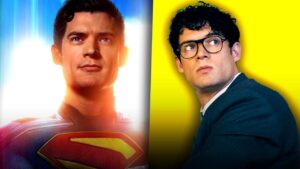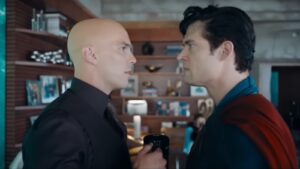Breaking Down Superman (2025)
Superman has been a pop culture icon for decades, appearing in comics, newspaper strips, radio broadcasts, prints, and films since his rise in 1938. Created by two Jewish American high school students, Jerry Siegel and Joe Shuster, Superman was, according to Roy Schwartz in his AJHS article “Superman’s Jewishness: From Page to Screen,” the “very first superhero, the archetype, (and) the urtext.” Not only does he represent Jewish identity, but he also acts as a blueprint for the “typical superhero.” He is innovative with his caped-style alone. In 1978, the movie Superman stepped into the cinematic limelight, starring Marlon Brando as Jor-El, Gene Hackman as Lex Luthor, Margot Kidder as Lois Lane, and Christopher Reeve as Superman himself.
As a Marvel girl, when I initially watched the film a few weeks ago, I thought it was a straightforward story. There didn’t seem to be anything startling about Reeve’s Superman except for his charisma and strength in every aspect of the word. He is righteous, almost one-dimensional with his persistent need to save others. Reeve’s version of Superman is classic, but as a person more into heroes like Iron Man and the Guardians of the Galaxy, I was expecting something more than just a glorious hero. I was expecting a hero with dimension, a man fighting an internal demon. Christopher Reeve’s Superman sounded too good to be true. I needed a Superman with a moral challenge.
(Spoilers for Superman (2025))
I got what I asked for when I saw Superman (2025). Written and directed by James Gunn, the new film takes place a few months into Superman’s (David Corenswet) relationship with Lois Lane (Rachel Brosnahan), and in this version of the story, she knows that Clark is Superman. Superman is still battling the evil Lex Luthor (Nicholas Hoult), but the genius has more than his wealth and supporters. He holds the lost half of the video Clark’s birth parents made for him before they died, and it is not a sweet message. In the lost half, they command Clark to dominate Earth, as humans are weak. It is completely distinct from what Jor-El told Clark in the earlier film — darker. Luthor uses this clip to his advantage, sharing it with the world to twist Superman’s good-guy image, bringing him down piece-by-piece.
Superman’s Origins
Many would say that Luthor exposing Superman’s parents discredits the superhero. It certainly does paint him in a dark light, but it also does something more. I believe that this reveal brings out the hero’s humanity, making him fully dimensional. This addition to his past also turns the main problem into a personal one, which, to me, makes the movie much more interesting. Another thing that this exposal does is bring out the nature vs. nurture conflict bubbling beneath the plot. It brings into question the things that have made Clark the remarkable being he is. In this story, nurture wins, because despite Superman’s alien parents telling him to dominate Earth, Superman refuses to obey their wishes. He was raised in an environment where conquering was unthinkable and violence was chastised. If he grew up with his birth parents (or watched the missing half

of the video as a child), perhaps he would have done something despicable with their commands?
Whether or not nurture won in the forming of Clark’s character, this exposal highlights the hero’s immense autonomy. He can process his birth parents’ wishes and hold onto his adoptive parents’ values while maintaining his own individuality. He can direct his own life and think whatever he wants about himself, even if the world’s perception of him is different. He gains thicker skin by experiencing a different perception of his heritage and the world he tries to save.
Villain Shenanigians
Luthor’s role in Superman’s situation increases his own evilness, creating more drama and fun for the audience. Twisting the image of anyone trying to do good is vile, so Luthor’s actions makes himself more realistic as a villain. We see politicians and entrepreneurs trying to bring down innocent people all the time. He is an allegory for corrupt business men (and presidents) in our world. Another thing that makes Luthor uniquely evil is his way of twisting the concept of intelligence and putting it against brawn, AKA Superman. He is constantly trying to prove to his enemy that his intelligence goes beyond their physical strength. It screams insecurity and obsession, making him appear like a bald-headed bully on the schoolyard.

Lovers
Another thing I enjoyed about Superman (2025) was Lane’s character. She is actually a part of the superhero action, working with Mister Terrific (Edi Gathegi) to help Superman instead of sitting on the sidelines, waiting for her caped-hero to take her flying. I also love the dynamic between her and Superman/Clark. She is not necessarily swooning over him like in Superman (1978). She has an agenda at the Daily Planet, a journalistic duty to carry out herself. Even so, she is still passionate about her boyfriend. They are more like a partnership with all its trials and doubts. It makes their relationship easier to connect with.
Sidekicks
I also loved that this film incorporates characters like the Green Lantern (Nathan Fillion), Mister Terrific, Hawkgirl (Isabella Merced), and Metamorpho (Anthony Carrigan). They each give the movie its emotional and comical flairs. Their presence sends this message out to the public: it takes more than one person to save a planet. The special effects of their powers were incredible to watch, too, particularly Mister Terrific’s. Also, I cannot forget Krypto the Superdog and Supergirl (Milly Alcock). It is fantastic to see smaller DC characters appearing in movies like Superman (2025).
Beyond the Screen
Perhaps the most intriguing part about Superman (2025) is its ties to Judaism and its supposed connection to the current Israeli-Palestinian conflict. As I stated earlier, Superman is the brainchild of two Jewish creators. David Corenswet is the first Jewish actor to play Superman on screen. Whether or not Corenswet’s heritage was one of the reasons why he was cast, it strengthens the film’s Jewish representation. Having him be Superman almost pays tribute to Siegel and Shuster.
There was a moment toward the end of the film where Jarhanpur, a fictional Middle Eastern country, is under attack by Boravia, a neighboring fictional country. During the attack, a little boy holds up a Superman flag and wishes for Superman to come and extinguish the attack. Some speculate that this moment is a parallel of the war between Israel and Palestine. I thought this scene was particularly poignant and impactful in regards to the Israeli-Palestinian conversation. Whether or not the scene is a depiction of the violence occurring in Palestine (Gaza), it makes Americans and other populations think about the damage being done in the Middle East, especially toward the children of Gaza.

And if the parallel is true, it is fascinating to see Superman’s, a character with Jewish origins, sidekicks beat out Israeli-coded enemies. It would send out this message: ethnicity or place of origin should not prevent people from saving innocent lives.
Overall, Gunn killed it with the writing in this project. The storyline is gripping, the characters are deeper than ever before, and the DC Universe has expanded its horizons thanks to Gunn. Superman (2025) is the addition to Superman (1978) that I needed to make a firmer conclusion about the hero, and my conclusion is this: even after eight decades, Superman is still our hero of heroes.

